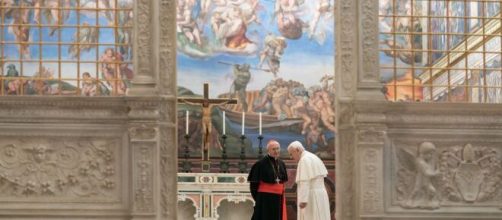Netflix's 2019 movie "The Two Popes" was in the news last week as an art story. But if you ask me, leaving aside that the movie is about the papacy, it was always an art story.
Dialogue-heavy scenes between Anthony Hopkins as Pope Benedict XVI and Jonathan Pryce as the soon-to-be Pope Francis could have been tedious if not for the Chapel setting brimming with Michelangelo's artwork.
Faking it
The movie boasts a room-size duplication of the Sistine Chapel, complete with the Renaissance master's paintings on the ceiling and the altar wall. The re-creation was needed because the Vatican doesn't permit filmmakers in the Chapel.
And even though the actors playing the priests can be riveting (you completely forget the roles they're famous for – Hopkins as madman Hannibal Lecter and Pryce as the writer Lytton Strachey), the copy of the Chapel steals the show.
This is especially true when Michelangelo's paintings are brought into the priests' conversation. The reproductions are so faithful to the original that the fact they're fake never enters your mind. Credit goes to the team of artists' skill at painting in the classical style.
But here's the thing. Regardless of the effort to reconstruct the Sistine Chapel and the expense (Netflix paid $5 million for it), the streaming giant ordered it destroyed immediately after the movie's shooting.
Artnet News asks why, and Netflix declines to answer.
Why did you do it?
You'd think practically that the replica would be saved for some future movie project, given that the Chapel is off-limits to filmmakers. In the past, when it came to showing Michelangelo's paintings, productions resorted to special effects.
Despite Netflix's silence to Artnet's question, the filmmakers were forthcoming. Production designer Mark Tildsley said the reason for the set's destruction was too big to store.
Not that all of the set was destroyed. Tildslely said it was cut down into pieces and distributed to crew members and producers and "anyone strong enough to carry some of it away." Tildsley took a section for himself to display in his living room.
Maybe Netflix didn't want to preserve the ceiling painting because it wasn't feasible. But why destroy the altar painting "The Last Judgment"?
Can it be that this streaming company is plainly crass, bent only on what comes next in its lineup? Or did Netflix order the destruction of "The Last Judgment" because of what it pictures?
The way Michelangelo saw the subject, his more than 300 bared bodies, add to a mighty grim picture of humanity. Maybe the doom and gloom made Netflix uncomfortable for airing so many movies with nude scenes typically seen on adult websites.
In contention
Exposed flesh in Michelangelo's painting was similarly characterized. Fellow artist Biagio de Cesena sneered that the nudity in "The Last Judgment" was better suited for a tavern.
After Michelangelo died, the Council of Trent ordered some of the nudes veiled. And despite a restoration effort, in 1990, the Vatican announced the veils couldn't be removed.
The art world is still upset about that. Maybe Netflix felt the need to stay clear of "The Last Judgment" controversies and stay out of the line of fire from critics for its long lineup of raunchy movies.
If I'm right about motives here, it's quite the sight gag that Netflix isn't shy about filling the silver screen with naked people but draws the line at the veiled nudes of "The Last Judgment."


